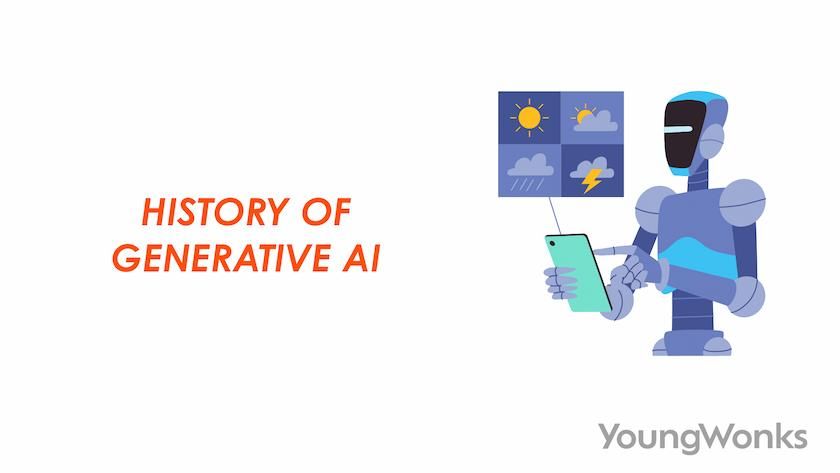Feb 03, 2025 By Team YoungWonks *
Introduction to Generative AI
Generative AI has a rich history deeply rooted in the realms of artificial intelligence (AI) and deep learning. Its journey began with the inception of computational models aimed at simulating human-like creativity and problem-solving abilities. Over time, it has evolved into a diverse field encompassing various techniques and methodologies for generating content, including text, images, and music. As we delve into the fascinating world of generative AI, let's pause for a moment to ponder some intriguing questions: What inspired generative AI? How has it impacted creative industries? These questions will guide our exploration as we journey through the history and evolution of generative AI.
History of Generative AI
Generative AI has emerged as one of the most transformative innovations in the field of artificial intelligence, reshaping how machines interact with the world and generate new content. Unlike traditional AI systems that focus on pattern recognition and decision-making, generative AI models are designed to create entirely original outputs, including text, images, music, and even video. This technology leverages deep learning, neural networks, and machine learning algorithms to simulate human-like creativity, making it one of the most versatile and groundbreaking advancements in AI.
The journey of the evolution of generative AI began with early rule-based systems and statistical models, gradually transitioning into self-learning systems capable of producing high-quality, realistic outputs. The development of Generative AI Models such as GANs, VAEs, and Transformers has redefined the capabilities of machines, making them not only tools for automation but also creative collaborators in various industries.
Recent breakthroughs like ChatGPT, DALL-E, and Stable Diffusion have demonstrated how generative AI is reshaping content creation, enabling both professionals and hobbyists to generate highly detailed and contextually rich outputs. With applications spanning computer vision, natural language processing, and synthetic data generation, generative AI is driving innovation across multiple sectors, including healthcare, entertainment, and art.
Precursors to Generative AI
The origins of generative AI can be traced back to early experiments in artificial intelligence that sought to simulate human intelligence and creativity. These early systems laid the groundwork for modern generative models by exploring how machines could produce content autonomously.
- Early Concepts and Philosophical Foundations: In the 1950s, Alan Turing introduced the concept of machine intelligence through the Turing Test, which proposed that a machine could be considered intelligent if it could imitate human conversation convincingly. This philosophical question laid the foundation for AI research, sparking interest in creating machines capable of generating new content.
- Rule-Based Systems: During the 1960s, Joseph Weizenbaum developed ELIZA, one of the first AI chatbots capable of mimicking human conversation through pattern-matching rules. Although ELIZA could not understand the meaning of its responses, it demonstrated the potential of machines to generate human-like text—a precursor to modern chatbots.
- Statistical Models and Markov Chains: The introduction of Markov Chains in probabilistic modeling further advanced generative capabilities. These statistical models generated text by predicting the probability of the next word based on previous words. While rudimentary, Markov Chains represented one of the earliest attempts to generate content automatically.
These early experiments highlighted the limitations of rule-based systems, paving the way for more adaptive and learning-based approaches in the following decades.
The Rise of Neural Networks and Machine Learning
The 1980s and 1990s marked the transition from rule-based systems to machine learning algorithms, which enabled machines to learn patterns from data rather than following hard-coded rules. This era laid the groundwork for many advancements in generative AI by shifting the focus from static systems to adaptive, self-learning models.
At the heart of this transformation were neural networks, which are computational models inspired by the structure and function of the human brain. Neural networks consist of layers of interconnected nodes, or neurons, that process information by assigning weights to inputs and passing the results through activation functions. This structure allows neural networks to identify complex patterns in training data and make predictions or generate new outputs.
The introduction of Recurrent Neural Networks (RNNs) and Long Short-Term Memory (LSTM) networks during this period significantly improved the ability of machines to process sequential data, such as text and speech. These innovations played a crucial role in advancing natural language processing and paved the way for more sophisticated generative models.
The growing availability of new data and improvements in computing power further accelerated the adoption of neural networks, setting the stage for the deep learning revolution that would redefine the capabilities of generative AI.
Neural Networks and Their Evolution
Neural Networks became a cornerstone of machine learning, drawing inspiration from the structure and function of the human brain. These networks comprised layers of interconnected nodes, each capable of learning complex patterns from data.
- Recurrent Neural Networks (RNNs): Introduced to process sequential data, RNNs became essential for tasks like text and speech generation. However, RNNs struggled with long-term dependencies, limiting their effectiveness in generating coherent content over longer sequences.
- Long Short-Term Memory (LSTM): Developed in the 1990s, LSTMs addressed the limitations of RNNs by incorporating memory cells that could store information over longer periods. This advancement significantly improved the quality of generated text and speech.
- Convolutional Neural Networks (CNNs): While traditionally associated with computer vision, CNNs also contributed to Generative AI Tools by enabling image generation and texture synthesis.
Variational Autoencoders (VAEs)
Around the same time, Variational Autoencoders (VAEs) emerged as a powerful tool for generating synthetic data. VAEs learned to encode input data into a compressed representation before reconstructing it, allowing the generation of entirely new samples from the learned distribution. These innovations laid the foundation for more sophisticated Generative AI Models, demonstrating the potential of machines to create high-quality, realistic outputs.
The Deep Learning Revolution
The 2010s ushered in the era of deep learning, driven by rapid advances in computing power, larger datasets, and more efficient algorithms. This period marked a turning point for generative AI, enabling the creation of highly realistic content across multiple domains.
Generative Adversarial Networks (GANs)
In 2014, Ian Goodfellow introduced Generative Adversarial Networks (GANs)—a revolutionary approach to generative modeling. GANs consist of two competing networks:
- Generator: Responsible for creating new content.
- Discriminator: Evaluates the authenticity of the generated content.
This adversarial training process pushed both networks to improve continuously, resulting in increasingly realistic outputs. GANs became a cornerstone of image generation, video synthesis, and deepfake creation.
Transformers and Large Language Models
The next breakthrough came with Transformer architectures, which replaced traditional sequence models like RNNs and LSTMs. Transformers enabled models to process entire sequences of data in parallel, dramatically improving both speed and performance in Natural Language Processing (NLP).
- GPT-2 (2019): Developed by OpenAI, GPT-2 demonstrated the ability to generate coherent, contextually rich text across various topics.
- GPT-3 (2020): With 175 billion parameters, GPT-3 became the largest and most powerful Large Language Model (LLM) of its time, revolutionizing text generation, summarization, and language translation.
- DALL-E (2021): A text-to-image model capable of generating high-quality images from natural language prompts.
- Stable Diffusion (2022): An open-source model that made high-quality image generation more accessible to the broader community.
- GPT-4 (2023): An even more advanced Generative Pre-Trained Transformer capable of multi-modal tasks, combining text and image generation.
These breakthroughs solidified Generative AI Models as powerful tools capable of creating new content across various media types, marking a significant stage in the evolution of generative AI.
Applications of Generative AI
Generative AI is reshaping numerous industries by automating the creation of high-quality content with minimal human intervention.
Healthcare
- Medical Imaging: AI models assist in generating enhanced medical images for diagnosis.
- Drug Discovery: Generative AI synthesizes new data for pharmaceutical research.
- Synthetic Data Generation: Privacy-preserving data for machine learning models.
Creative Industries
- Image Generation through tools like Midjourney and DALL-E.
- Music composition and video game content generation.
- AI-powered graphic design tools.
Chatbots and Conversational AI
- Customer service automation with ChatGPT.
- Virtual assistants with speech recognition capabilities.
- Multilingual translation services.
Gaming and Virtual Worlds
- Procedural content generation.
- NPC dialogue creation.
- Realistic texture and animation synthesis.
Customizing Generative AI Models
With the rise of open-source models, AI engineers can now customize LLMs for specialized applications.
- Fine-tuning on domain-specific datasets.
- Prompt engineering for tailored outputs.
- Using Synthetic Data to enhance model performance.
Cost of Generative AI
The cost of generative AI can be significant, posing a major barrier to widespread adoption. Several factors contribute to these expenses:
- Computing Power: Training advanced generative models requires high-performance GPUs or specialized hardware, which can be extremely costly. The demand for massive computational resources often makes AI research and development accessible only to well-funded organizations.
- Training Data: High-quality training data is essential for improving model performance, but acquiring, curating, and storing large datasets adds substantial expenses. Moreover, the need for diverse data to mitigate biases increases the complexity and cost of the data collection process.
- Cloud Services: Cloud infrastructure from providers like Microsoft and NVIDIA offers scalable AI solutions but often comes with steep subscription costs. Smaller companies or independent developers may struggle to afford these services.
- Maintenance and Fine-Tuning: Once deployed, generative models require continuous new data for retraining and fine-tuning to maintain accuracy and performance, adding to long-term operational costs.
Despite these challenges, the growing availability of open-source tools and pre-trained models is lowering the entry barriers, making generative AI tools more accessible to developers and smaller businesses. However, the financial divide between large tech companies and smaller players remains a critical issue, potentially concentrating AI capabilities in the hands of a few powerful entities.
Ethical Considerations
While generative AI offers transformative possibilities, it also introduces complex ethical challenges that must be carefully addressed:
- Deepfakes and Misinformation: The rise of AI-generated media, including deepfakes, poses significant risks to public trust and the spread of false information.
- Copyright Infringement: Generative models trained on copyrighted content may inadvertently reproduce or imitate proprietary works, raising legal and ethical questions about intellectual property rights.
- Bias in Training Data: Many generative models inherit biases present in their training data, resulting in skewed outputs that can reinforce social inequalities.
- Privacy Risks from Synthetic Data: While synthetic data can improve data privacy, poor implementation may still expose sensitive information or be used to generate realistic but fake personal data.
To navigate these issues, the AI community must adopt robust ethical frameworks, prioritize transparency, and implement responsible AI practices. Striking a balance between innovation and accountability will be crucial as the evolution of generative AI continues to reshape society.
Conclusion
The evolution of generative AI has been nothing short of remarkable, transforming from simple rule-based systems to highly sophisticated models capable of generating human-like content across diverse domains. From the early days of ELIZA to the advent of GANs, VAEs, and Transformers, each breakthrough has pushed the boundaries of what machines can create. This rapid advancement is driven by the exponential growth in computing power, access to massive datasets, and the refinement of machine learning algorithms.
Generative AI is no longer confined to experimental research; it is now a driving force behind innovations in healthcare, entertainment, art, and beyond. The rise of Generative AI Tools like ChatGPT, Stable Diffusion, and Midjourney has made high-quality content generation more accessible than ever before. As models continue to evolve, they are unlocking new possibilities for personalized experiences, synthetic data generation, and collaborative creativity between humans and machines.
*Contributors: Written by Kabir Pandey; Edited by Disha N; Lead image by Shivendra Singh

